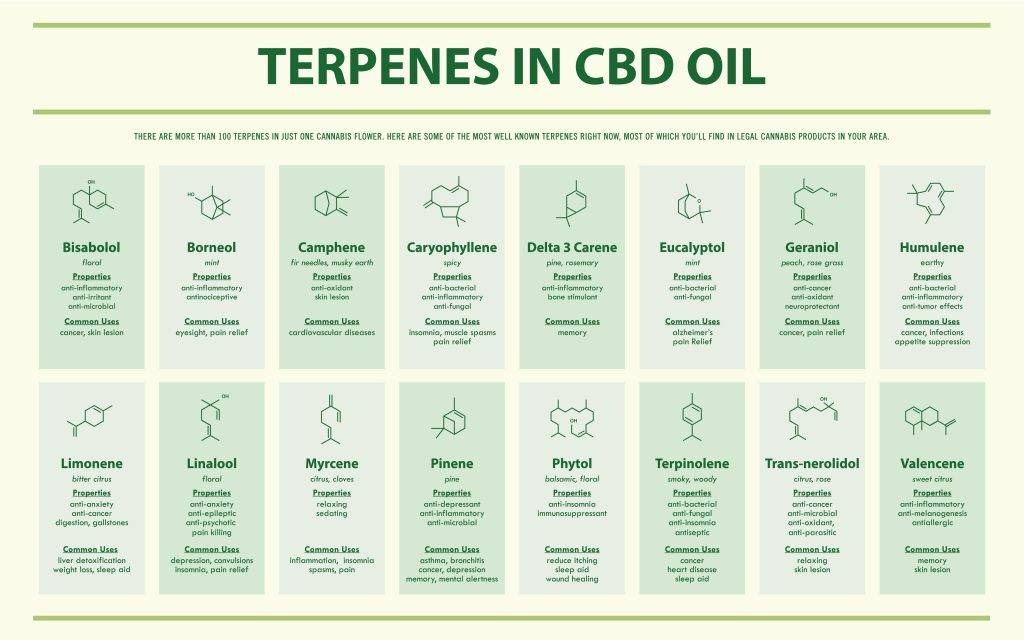Have you ever wondered why some plants and herbs have distinct and powerful smells? That’s because of terpenes, which are organic compounds that are found in plants and have different properties that the scientific world is still studying. Terpenes can be very different from one plant to another, as they are found in plants that include lavender and even cannabis. But what is it that we do know about terpenes, why is it commonly associated with cannabis, and what are the effects that these organic compounds can have on the human body?
What are Terpenes?

In other cases, terpenes take the role of protectors and can help plants recover from damage. Sometimes, terpenes can prevent a plant from getting sick all together because they can be a vital part of the plant’s immune system.
In today’s modern industrial age, brands are using terpenes and their compounds to create scents of flavors of many different products: from foods to perfume.
It is important that you know the difference between terpenes and terpenoids, two terms that are often used interchangeably when they’re actually two different things. Terpenoids are actually modified terpenes. How does this occur? Terpenes are organic compounds found in living plants. When the plant dries, the structure of the terpenes changes and they become terpenoids through the process we all know as oxidation.
Terpenes vs. Cannabinoids
Plenty of people hear about terpenes and immediately think about cannabis, but are these two actually connected to one another? Just as terpenes are organic compounds found in plants, cannabinoids are the chemical compounds found in the cannabis plant. On a chemical level, different types of cannabinoids will activate receptors that are found in the human endocannabinoid system, one of the most common ones being tetrahydrocannabinol. You may also have heard about cannabidiol, which is now being used for its medical properties.
What you may not know is that you can also find terpenes in the cannabis plant. Terpenes can have an impact on the body’s endocannabinoid system but the body will absorb this compound in different ways.
The Effects on the Body
If you consider the fact that terpenes are bioactive, then it makes perfect sense that they would impact the human body one way or another. The way in which the body reacts will depend on the concentration of terpenes that is found inside the body and how people consume it.

There are some researches out there who support the belief that terpenes will enhance the drug-like effect that people get whenever they use cannabis. Also known as the “entourage effect”, terpenes are believed to alter the effects of tetrahydrocannabinol and cannabidiol in the body.
According to a review published in the Frontiers in Neurology, people who suffered from epilepsy had improved symptoms when taking a CBD-rich extract compared to those who took purified cannabidiol. That would suggest that the way in which the human body makes use of cannabidiol can be affected by some of its other compounds, terpenes included.
Types of Terpenes
The natural world is filled with all sorts of terpenes, so let’s review the most commonly-found ones:
- Limonene has a very specific scent that most people will be able to recognize. As you can imagine, it has that citrus-like scent that you know from oranges and lemons. According to a study, these terpenes are antioxidants, anti-inflammatory, antiviral, and antidiabetic. It is also found in supplements.
- Linalool is a terpene found in lavender plants and it is commonly found in the lavender plant. Naturally, it is a terpene often used in aromatherapy since lavender essential oil is one of the most sought-out ones. It is also known for its therapeutic uses, as it can help calm down anxiety, acts as an antidepressant, but it’s also antimicrobial and anti-inflammatory.
- Beta-caryophyllene can commonly be found in vegetables and cloves. It has an anti-inflammatory effect and is capable of lowering pain levels in certain situations.
- Humulene is mostly found in hop plants, but also in ginger and clove. According to some studies, humulene can prevent certain allergic reactions and it’s also good for people who have asthma because it can reduce airway inflammation.
- Myrcene is found in thyme and lemongrass, amongst other plants. It is known for its antioxidant properties, but there are many studies which led researchers to believe it could have properties such as protecting the heart tissue. One particular study focused on the cell model of osteoarthritis and it showed that the anti-inflammatory properties of myrcene can prevent cartilage cell breakdown. This could mean that myrcene can be useful in the production of osteoarthritis medication.
Conclusion
Terpenes are compounds found mostly in plants and are responsible for their scent. People often associate terpenes with cannabis, but they are found in other plants as well. While there are some things we know about them, the subject of terpenes is still being studied and researchers feel that there is still much to be discovered about the therapeutic benefits of these compounds.


